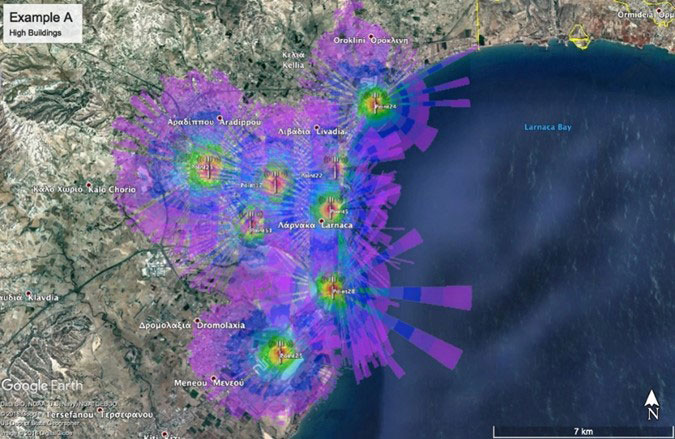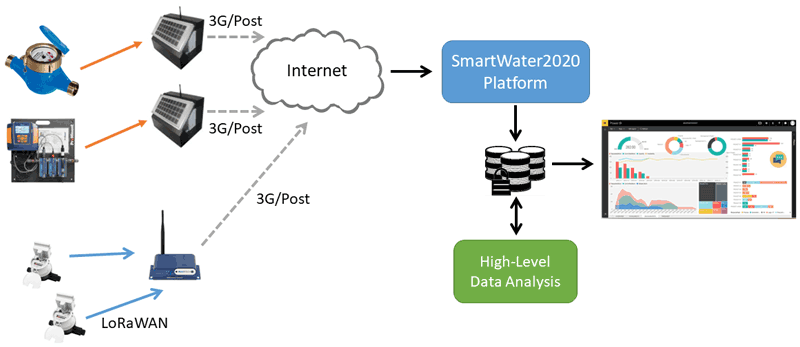by George Tzagkarakis (FORTH-ICS), Maria N. Anastasiadou and Demetrios G. Eliades (KIOS, University of Cyprus)
“Lost water” in drinking water distribution systems is the water that enters the distribution network but never reaches the consumer, owing either to leakages or because it is not metered by the water utilities. SmartWater2020 is a research project that is working to develop a smart platform for real-time condition monitoring and autonomous pressure control in urban distribution networks, with the goal of reducing telemetry costs and water losses.
Drinking water supplies face pressing issues, particularly in island regions, where climate change, water scarcity, pollution and the high cost of desalination are putting pressure on water distribution organisations. At the same time, 15-25% of the drinking water produced is lost via invisible leakages, which represent a main contributor to non-revenue water. From an economic perspective, the cost of lost water worldwide, due to leakages, metering errors and non-billed consumption, is about US$15 billion annually. In developing countries, more than 45 million m3 of treated water is lost due to leakages each day. The challenge for water utility companies is to save resources, thus improving water sustainability. Innovative monitoring and control technologies to reduce water loss can help achieve this.
The SmartWater2020 project [L1], funded by the INTERREG V-A “Greece-Cyprus 2014-2020” Cooperation Programme, focuses on developing smart technologies to support water utilities in the islands of Crete (Greece) and Cyprus. The goal is to significantly reduce water losses by improving condition monitoring and control of their water distribution networks. The project’s activities span four major axes: (i) installing innovative technologies, including pressure and quality sensors, autonomous smart meters and pressure reduction valve controllers, in households and water supply networks; (ii) optimal deployment of the communication infrastructure (IoT, LoRaWAN) by accounting for the hardware’s specifications, the terrain’s characteristics, and the buildings’ position and height; (iii) modelling water distribution networks based on the EPANET platform for generating artificial data and simulating “what-if” scenarios; and (iv) developing smart algorithms for telemetry cost reduction, early warning of leakage events and water quality issues, automatic pressure control, and data visualisation.
Commercial sensing, metering and telecommunications hardware is utilised, according to the specific needs of the involved water utilities. A software tool has been designed in-house (FORTH-ICS), which employs the sensors’ specifications along with the geography and urban layout of the monitored area, and calculates the optimal locations for deploying the sensing and communication infrastructure to guarantee full and robust coverage of the monitored area (ref. Fig. 1). Furthermore, it is critical for water utilities to be capable of simulating “what-if” scenarios, in order to predict the effects of specific actions undertaken by the network operators, or to examine the influence of abnormal events. To this end, a software tool is provided by KIOS-University of Cyprus, based on EPANET, for modelling hydraulic and quality dynamics of a water distribution system (ref. Fig. 2). In addition, the Leakage Diagnosis Benchmark (LeakDB) [L2], developed by the team of KIOS-University of Cyprus, is a free tool for generating realistic leakage datasets from different water distribution networks under varying conditions.

Figure 1: Optimal antennas’ deployment in the city of Larnaca based on the LoRaWAN technology.

Figure 2: The SmartWater2020 platform architecture.
At the core of the SmartWater2020 platform (ref. Fig. 2) is the high-level data analysis and visualization engine developed jointly by FORTH-ICS and KIOS-University of Cyprus. First, motivated by the need to reduce telemetry costs for the water utilities, an efficient data compression method has been developed based on the theory of compressive sensing (CS) [1]. CS enables simultaneous data acquisition and lightweight compression, thus reducing transmission costs by putting the computational burden to the side of the control room, where increased computational resources are available. Having received the recorded data in the control room, the SmartWater2020 platform supports a set of high-level analysis functionalities. These include: (a) recovery of missing values due to sensors or network malfunction; (b) real-time correlation monitoring of the received data streams to reveal hidden interdependencies among the sensors; (c) early warning for abnormal events by combining the recorded data with hydraulic models [2], along with advanced algorithms for the uncertainty-aware localization of leakages; (d) estimation of water quality conditions in areas which are not monitored by sensors (in the case of unobserved contamination events, the platform supports the utilization of an Active Contamination Detection scheme [3], which facilitates the detection and isolation of the contamination propagation path and its possible source through valve control); and (e) reduction of background leakages through pressure control, by jointly solving an optimization and control problem for deciding the most appropriate valve settings in order to reduce the overall and worst-case pressures within the metered areas. Finally, the recorded data, along with the high-level analysis outcomes are visualized in a versatile, yet user-friendly, interface designed in-house in close collaboration with the participating water utilities in order to fit perfectly their needs.
Links:
[L1] https://www.smartwater2020.eu
[L2] https://github.com/KIOS-Research/LeakDB
References:
[1] G. Tzagkarakis, J. P. Nolan, and P. Tsakalides: “Compressive sensing using symmetric alpha-stable distributions for robust sparse signal reconstruction,” IEEE Trans. on Signal Process., 67(3), pp. 808-820, 2019.
[2] S. G. Vrachimis, D. G. Eliades and M. M. Polycarpou: “Leak detection in water distribution systems using hydraulic interval state estimation,” in Proc. IEEE CCTA, 2018.
[3] S. G. Vrachimis, et al.:”Active contamination detection in water-distribution systems,” J. Water Resources Planning & Management, 146(4), 2020.
Please contact:
Marios M. Polycarpou
KIOS Research and Innovation Center of Excellence, University of Cyprus, Cyprus
Panagiotis Tsakalides
FORTH-ICS, Greece











